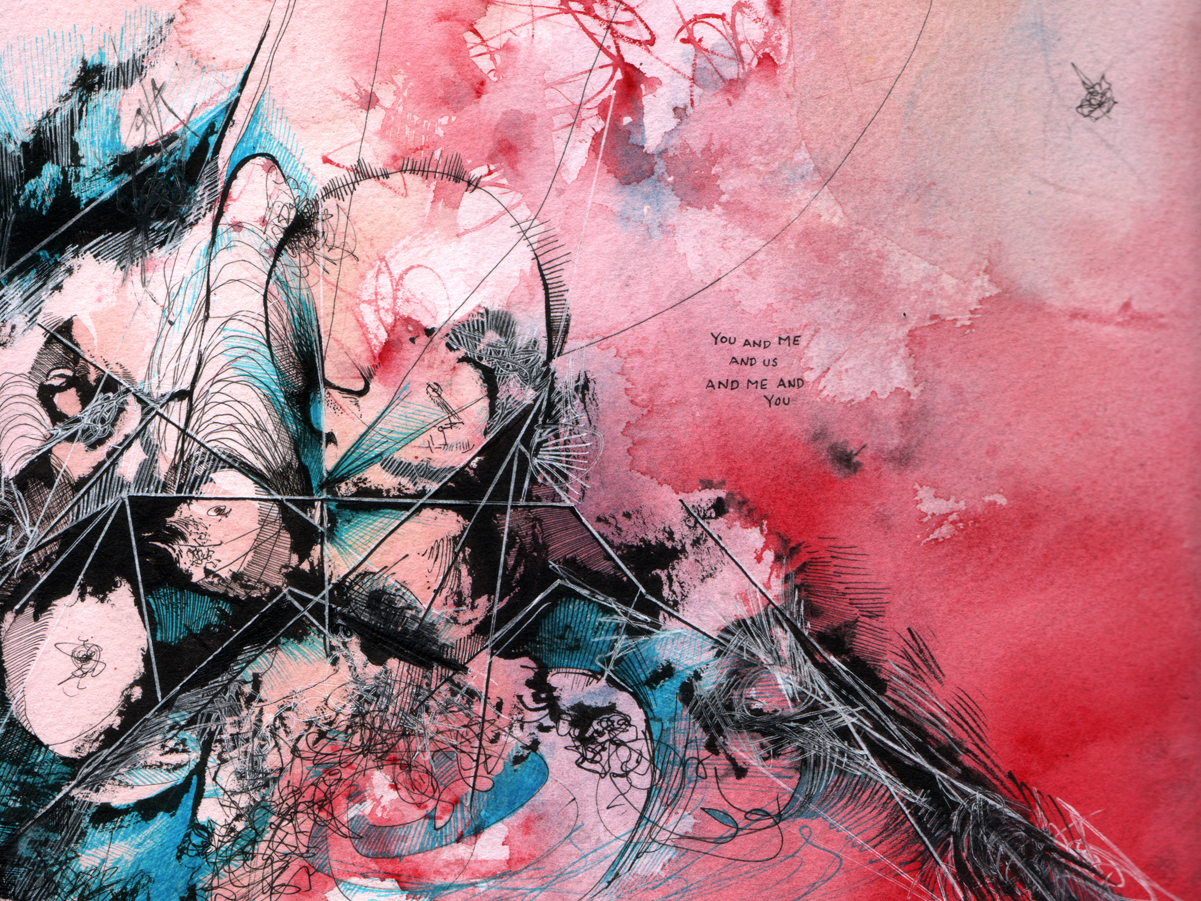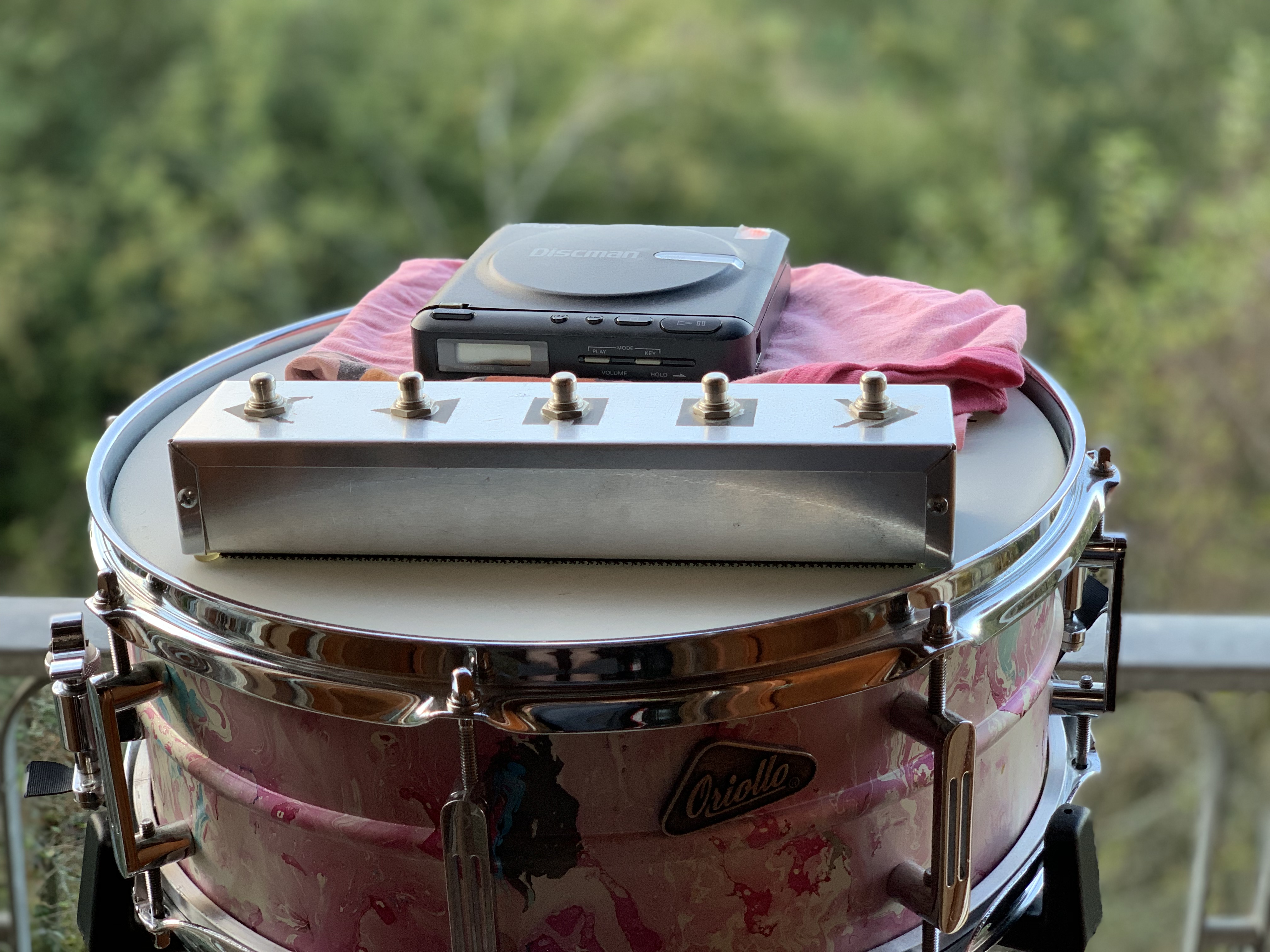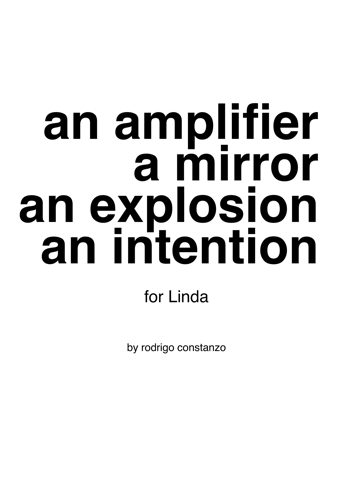You and Me and Us and Me and You
I like to picture that there are an infinite number or realities, all running in parallel. The entirety of my existence, everything I have ever known is but one of these. I represent a single point on this infinite line.
There are moments in your life where you feel that infinity collapse. The things, moments, and people that exist across the multitudes of possibilities. These create a mirroring, an echo, a shimmer across these realities. You are no longer you, you are the infinite you. You stand across all time. You see the infinite.
Sometimes you live this without even knowing it.
This is a blog post about infinity. Specifically infinity minus one.
Rhythm Wish
Although this idea/piece is a couple of years old now, I realized I’ve not written about it in any detail (although I have talked about it on several occasions). So this is that. But more than that, I want to talk about what this idea isn’t, and how gloriously isn’t it is.
This is story of how a complicated idea became simpler and simpler until nothing else was left but its core.
Black Box project
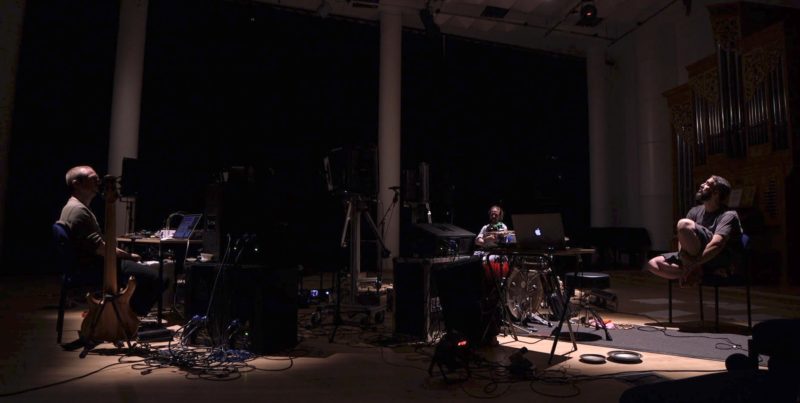
The Black Box project is a project that involves Pierre Alexandre Tremblay on bass/electronics, Patrick Saint-Denis on robotics/electronics, Sylvain Pohu on guitar/electronics, and myself on drums/electronics. It’s a four-way collaboration that has gone through two residencies (in Montreal and Huddersfield), to work out the finer details of putting a large-scale show together.
It looks and sounds something like this:
dfscore 2.0

dfscore 2.0 is here! dfscore 2.0 is a much improved and completely rewritten version of dfscore that I started working on a couple of years ago. The dfscore system is a realtime dynamic score system built to display a variety of musical material over a local computer network. The primary motivation for building the system was to allow for a middle ground between composition and improvisation.
But before I get into all of that, here is a video showing the latest version along with its premiere at the Manchester Jazz Festival:
Titles (synchronicity, time travel, magic, etc…)

A Possibility:
Title as prophecy. The art and muck that you are involved with bends around you, is bigger than you, is smarter than you. It points in a direction that you could not conceive. That you could not imagine. It becomes the truth, out from under you. It is an arrow. It is a line.
<as point on line>
You’ve named a thing. It becomes your future.
You name the thing. It becomes a fictional present.
You have to name a thing. Do you give, to become the art?
Which future does the arrow point towards?
You are the single point at which the Universe will crease.
</as point on line>
A Possibility:
Title as bound poetry. You become the filament. The rod. You are honest. And you touch god, the bottom. You can see everything. Naked, you channel truth into a list of things.
<while shivering>
Uncertainty.
You extend yourself. All of the way.
Profoundly. Endlessly.
Nothing is more important than this moment.
</while shivering>
A Possibility:
Title as arc. There is a beginning, with its end built in. It starts before you are paying attention, and finishes after you’re ashes. It is made up of everything around you. It is a resonance through multiple points of time, folded over each other.
<righting, writing rites>
You become aware of it happening. You make a note.
You live the life required of you.
You are becoming the art.
Your life and the art, are folding together.
It makes sense.
The end is here. The end was always (t)here.
</righting, writing rites>
pǝʇsᴉxǝ ɹǝʌǝ sɐɥ ʇɐɥʇ ƃuᴉɥʇʎɹǝʌǝ oʇ sʎǝʞ ǝɥʇ ˙III ‘uoᴉʇuǝʇuᴉ uɐ ‘uoᴉsoldxǝ uɐ ‘ɹoɹɹᴉɯ ɐ ‘ɹǝᴉɟᴉldɯɐ uɐ ˙II ‘ɯoɔ˙(pǝɯɐuun)/ɯoɔ˙ʎssndɹnoʎʇoƃɹoɟʎpɐǝɹlɐᴉ/ɯoɔ˙lɹᴉƃɹǝɥʇouɐɥʇᴉʍǝʌoluᴉɯᴉ ˙I
Making decisions in time

///////////////////////////////////////////////////////////////////////////////////////////////////////////////////////////////////////////////////////////////////////
Table of Contents
Background
Development
Implementation
Analyses
The Future
///////////////////////////////////////////////////////////////////////////////////////////////////////////////////////////////////////////////////////////////////////
Background
It started with a simple question: “Why compose at all?”
At the time I was working on what would later become iminlovewithanothergirl.com and was trying to figure out how to deal with composing for myself as an improvising solo performer using a new/invented instrument which is difficult to reproducibly control. This marked a big shift in my compositional thinking. I began moving away from precomposing discrete gestures and started focusing on pure improvisation. I carried on this line of thinking through multiple compositions and projects over the next three years and eventually produced a framework for thinking about improvisation – making decisions in time.
Everything. Everything at once. Once. (3)
Here is the 3rd iteration of my ongoing series of pieces ‘Every. Everything at once. Once’.
Before I gib gab about it, here is “Everything Everything at once. Once. (3a)”:
The idea for these pieces is to focus my creative process and energy on the curatorial act of choosing the instruments I will improvise with. This has now extended into the choosing of the location, look, and visual approach used in each video. Each video in the series has had its own distinctive look, and has also come to include new collaborators alongside my long-time collaborator Angela Guyton.
Going into this third video, I knew I could try something different, because of the acoustic (and battery powered) nature of the instruments chosen. A melodica (which I bought over 15 years ago at a flea market for $5!), and my trusty ciat-lonbarde Old Mr. Grassi. I first thought about using some kind of outdoor location, but after seeing David Pocknee and Michael Baldwin‘s basement, I thought that it would be a wonderful place to film.
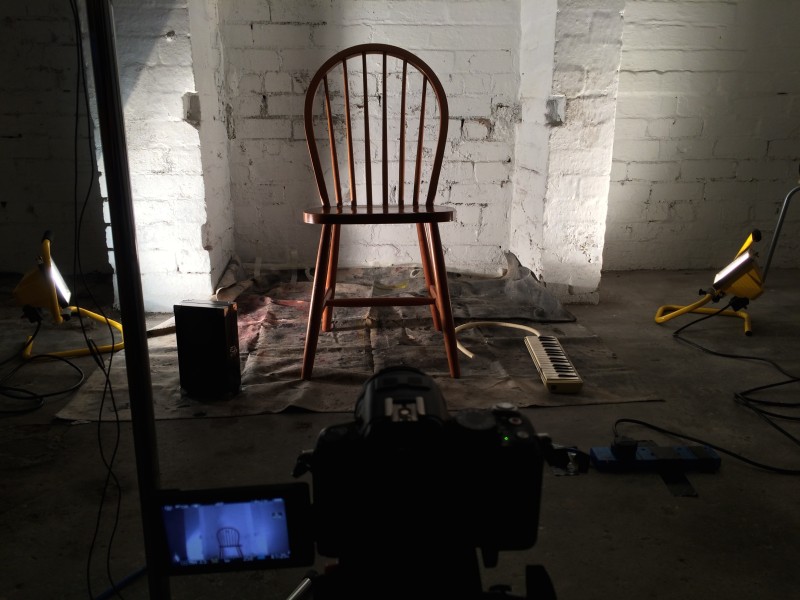
The original idea was to use some dripping paint, with David and Michael each having a squirt bottle, and then adding some vertical glitching artifacts similar to the language Angela had explored in her latest video. But after doing a take with the paint, and seeing how amazing the lighting by David and Michael was, the paint/glitch idea was scrapped altogether. Angie thought that with David and Michael enacting two tasks, what their role meant within the work changed. It created a different context and gave the work a different character, but one that didn’t seem as complete as when they were focused completely on their dispassionate navigation of the space as they sensitively manipulated the lighting.
I was initially hesitant about this change, since I was quite excited about the paint/glitch idea, but I trusted Angie’s judgement on the matter. And in the end, the videos came out better.
The choice of instruments for this particular version of the piece is far smaller than the other versions, with just two instruments:
1 x ciat-lonbarde Old Mr. Grassi
1 x Artist Ltd. Pianica
The first version had 10 instruments, and the second version had 18.
That being said, this particular combination of instruments is one of my longest standing ‘pairings’, going to back to when I initially started performing solo improv. In that sense, it served as an almost proto version of this creative thinking. Some of the language in the third video (3c), particularly the near-unison sustained pitches, diatonic-y material (Gminor?!?!), is something I strongly associate with this particular combination of instruments.
Even though the combination of instruments is quite old for me, I wanted to incorporate that specific pairing into this compositional framework, where the choice of instruments defines the piece.
I am still, however, surprised at the endless source of inspiration these instruments provide. It almost feels like cheating, at this point, given how interesting the instruments sound, but I felt I found lots of new and fresh angles on them. My work on the Battle Pieces, .com pieces, and dfscore system has given me such a fluid understanding of form, gesture, and pacing, that I can really focus on multiple formal levels while attending to the micro/developmental nature of the sounding materials themselves.
The visual identity of these pieces is becoming something that is increasingly important, which in this case specifically involved dynamic manipulation of light. This tendency has been apparent in all of my work over the last few years, but each one of these videos, particularly, has a very considered visual identity and approach. I am curious to see where this will go, and if the general idea of these pieces (to draw a metaphoric circle around the part of the creative act I want to focus on) will explicitly be extended to the entire ‘art object’.
When asked, after filming the videos, to describe what we thought was important using only three words (Michael had asked David this question before), Angela and I shared two of the three words: creativity and love. We disagreed on sharing vs freedom for the third word, but what can you do. I am comforted by the fact that I’m right and she’s wrong.
iminlovewithanothergirl.com – Full Length
Very happy to post this full-length version of iminlovewithanothergirl.com. Even though I’ve talked about the piece several times, and have posted multiple versions of it, I didn’t have a full-length ‘studio’ version of it. Until now.
Behold:
It was an interesting experience coming back to a studio version of the piece. The very first version of it (that existed before the idea fully coming together as a composition) was really just a document of the snare/friction/feedback ideas I had been playing with. The lights only really joined in for that document, and then were incorporated into the actual piece, once it started congealing.
Since that video, I’ve performed the piece live numerous times, and each time I discover new facets to the feedback playing, and general language/syntax of the piece, but these generally happen as one-off events. Leading up to the initial composition and studio version I did a boot-camp type working process, where each day I would compose new material, record myself performing it (and previous days materials), improvise freely, and finally listen back to everything. That really helped me refine the language and discover new playing techniques. When I’ve performed the piece live, I did not have that luxury of a long period of prep (at the venue), so I would draw on my existing knowledge, as well as exploring the sonic characteristics of that venue and space. The most recently live performance (at Kammerklang) had some very unique and interesting feedback properties that I hadn’t experienced in other venues before. You can see/hear that video here.
Leading up to this studio version, I prepared by doing daily boot-camp like practice of the materials. In doing some I developed and explored some new sounds and syntax which bring a fresh life now to this now nearly 2-year old composition.
Seeing what came before, and what came after, this piece definitely marks a massive shift in my creative thinking, and still stands as one of the best things I’ve done creatively. (this is still the best)
dfscore
Here is a short video introduction of the dfscore system, which I’ve been working on for some time now.
The dfscore system is a dynamic score display system built to function over a local network to display a variety of musical material. The primary motivations for building the system were to allow for a middle ground between composition and improvisation, and to be able to dynamically restructure and reorchestrate material on any given instrumentation.
The first performance utilizing the system will be on the 18th of September at The Noise Upstairs.
You can read more about the project here:
In progress
The last few months have been both slow and busy at the same time. In that time I’ve been slowly working on multiple pieces/projects simultaneously. I figured it might be interesting to make a blog post about things in progress.
After finishing a piece for good friend Linda Jankowska and the end of last year I started working on two other pieces. The first one being a piece for skipping CD player and drumset. The working title is “Rhythm Wish”, but I’m not fully settled in on that. It looks/sounds something like this:
The piece, compositionally, will fall somewhere between two approaches I’ve been working on recently. First the kind of open/memory/improv structure of pieces like the .com pieces, and to a lesser extent ‘an amplifier‘, and the game/challenge/etude modes of interaction found in the ‘Battle Pieces‘ from a duo (strikethrough me & you) with another good friend Sam Andreae.
The piece will be constructed in a way that before the performance the performer (either myself or David Meier) has to improvised some material, given certain prompts. Those materials will then be burned onto a CD player (with the un-muted modification ala Nic Collins CD Hacking). The CD player will sit on the snare drum (as in the demo video I made above), which will cause the CD to skip around and act unpredictably. That glitchiness (along with the order of the tracks on the CD) will form the structure of the piece at a larger level. The more local interactions will be defined by challenge/interactions that the performer will have to engage with, along with the recorded version of themselves.
There will also be some real-time ‘nudging’ of the CD player via a footswitch that I hacked together from an old remote control for the CD player.
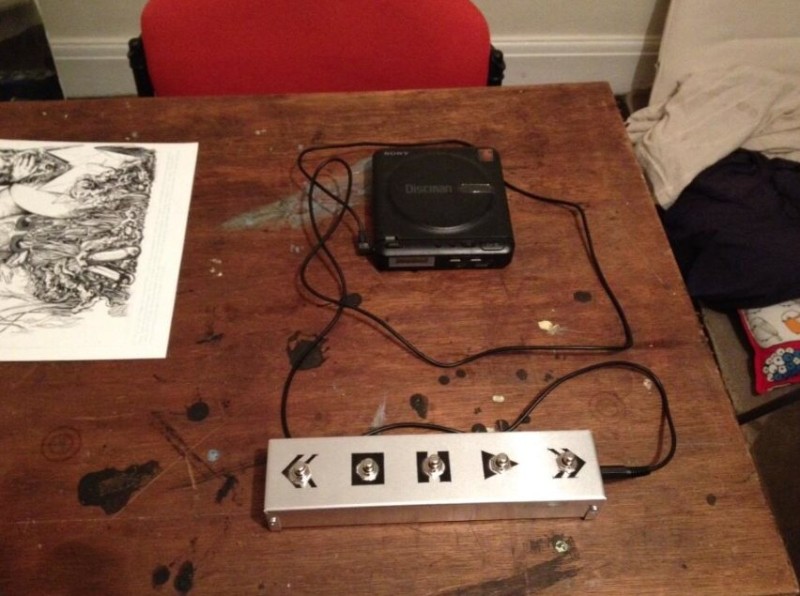
As evident in the video, the sound of the CD player blurs with the sound of the acoustic drumset, which is very much intentional. Some of the seedling ideas for the piece were of a sort of temporal duality. With a protagonist/antagonist fighting it out musically, one being live and one being recorded. I like the poetics of it being the same person/instrument with the conflict coming only via the displacement in time (then vs now, past vs present). I took these ideas and played around with a ‘3-act play’ structure, which is still somewhat present in the larger structural framework, but is less important than it originally was.
I will also play with illusion in terms of what is real and what is recorded. This kind of interaction was a mainstay in the performances of the performance art duo I have with Angela Guyton, Takahashi’s Shellfish Concern. During the era that relied on live painting + live sampling, the idea of hearing the sound of the lines being put down, then not hearing them (or hearing a different recording) when seeing it happen again proved to be very powerful. This was very much inspired by the ‘Club Silencio‘ scene from Mulholland Drive. (more on Takahashi’s Shellfish Concern below)
In addition to the ‘Rhythm Wish’ I am also working on a piece for tuning forks and computer hard drive. It looks/sounds something like this:
The piece will be for four performers all sitting around a table, with the computer hard drive in the middle. The piece is written for a new ensemble I’m performing in called bird rat centipede and will be called ‘the keys to everything that has ever existed’.
The main compositional material of the piece will be ‘privacy’. In the sense of ‘hitting the tuning fork on the table and pressing it to the table’ being a ‘public’ sound, and ‘hitting the tuning fork on your knee and holding it near your ear’ being a ‘private’ sound. I very much like the idea of multiple perspectives on the same piece, particularly since there is no ‘real’ perspective. Each performer hears a, literally, different version of the piece, and same goes for the audience and/or recording.
The computer hard drive is modified with an ‘analog HD’ by Gijs, which is essentially 3 oscillators and an amplifier driving the voice coil in the hard drive (so it acts like a speaker).
I’ve also started working on my dfscore system, which is a networked laptop score displaying software system I’ve been working on for a while (which has taken a bit of a back burner position for a bit). I used a very stripped down version of it in ialreadyforgotyourpussy.com with Richard Craig, which looks/sounds like this:
I had pitched the idea to the Manchester Jazz Festival last year, and although it was not accepted, I did continue talks with them. The project is now moving forward again and is, quite unusually for me, being financially supported by Jazz North. I’ll have more details on this soon, but it is very exciting to be working on the system again.
It will eventually be a software system that you can quickly install on any number of laptops which are connected up via ethernet cables (for minimal latency). This will allow for a more dynamic/adaptive type of composition which would work very well with the kind of music I’ve been writing as of late. I will also be openly sharing all of the code and try to make it as user friendly as possible.
I’ve also finished putting the finishing touches on this MIDI to relay system built for me by Circitfied (Dan Wilson). I commissioned Dan to build a box that would take MIDI messages and turn on/off relays which I would connect to a bunch of ciat-lonbarde instruments. The box on it’s own is pretty cool/exciting (not to mention great looking!) but it will be much more so once I pair it with some crafty programming.
I plan on building several modules to drive it, including an attack detection to random re-patching, and a much more challenging/exciting analysis-based system where I can analyze the audio descriptors (using Alex Harker‘s externals for Max) of each combination made by the box, then by analyzing incoming audio, create a resynthesis of that audio using repatching/reconfiguration! Very similar to the synthesis used in my CCCombine Max patch, but instead of using a bank of samples, it would use hardware synthesis/sounds.
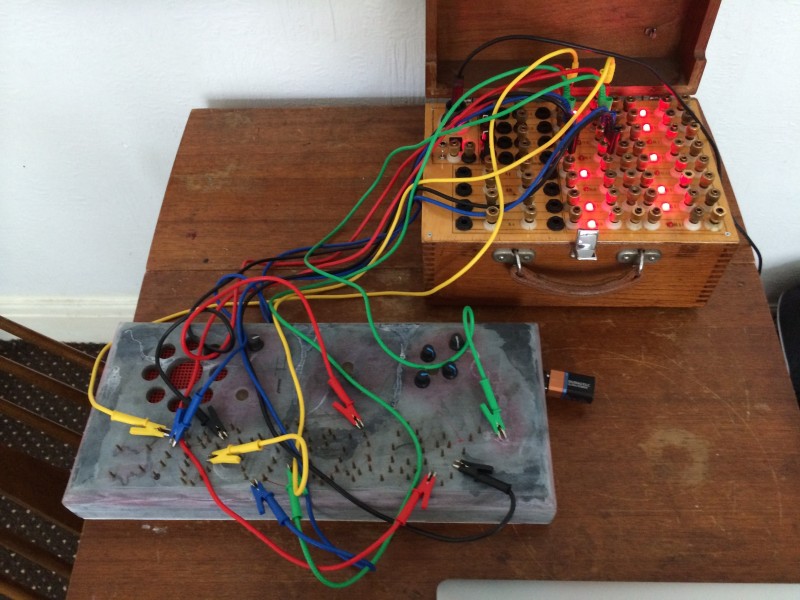
Lastly (but not leastly) is a continued development with the next phase of Takahashi’s Shellfish Concern. We’ve moved away from an amplified canvas and towards a DMX lights based setup. That looks something like this (though not directly focused on Angie):
The trajectory of the work has been moving further and further away from an ‘art object’ in the last few years, so this is the final ‘jump’ away from physical stuff. Most of it is still based around an image, but now it’s smeared in time/space by using flashing lights as the only visual component. The sonic component is still being worked on, though it’s mainly been sampled voice/breathing.
Everything. Everything at once. Once. (2)
Back in October of last year I came up with a new idea on how to approach some of the music I’ve been making. The basic idea was to put the creative or ‘compositional’ focus on the instrumentation part of the process of music making (this being a very important aspect of music making, and improvisation specifically). As obvious as this seems, and as much as it’s actually part of my creative process, I had never focused on it explicitly.
The pieces in this series are called: “Everything. Everything at once. Once.” with each subsequent version increasing in number, and with letters added for each performance using that setup. In October I created versions 1a/1b/1c. Below are versions 2a/2b/2c/2d. All of them were filmed by Angela Guyton and close friend Linda Jankowska, who inspired the general musical approach.
Here is “Everything Everything at once. Once. (2a)”:
The way I’m approaching the pieces is that the videos themselves are the pieces. They aren’t instances of the piece. The ‘score’ for each piece is the point of departure to create the videos. I don’t intend on returning to any of the setups/approaches, not as part of this series anyways. As mentioned above this is mainly to highlight that part of my creative process which is, increasingly, less focused on the false dichotomy of ‘improvisation vs composition’. I’ve used this framework for many years but it’s not well suited to how I actually approach music making. There is no ‘before’ (as in compositional pre-planning) or a ‘now’ (as in the immediacy of improvisation). There is a single stream that runs through all of this. There are just decisions, happening at all points of the process.
Everything. Everything at once. Once. (2b)
For this second (2) piece in the series I wanted to focus on percussive sounds in the context of skipping CD style glitching. A toy piano and various metal percussion instruments are the main sounding bodies used in the piece. The glitching comes from software I’ve written. The Party Van is my all-in-one software that I use in nearly all my performances that involve a computer. A subset of that patch is The Chocolate Grinder which is built to emulate and behave like a skipping CD. I’ve used this kind of sound world in the past but wanted to be able to use it with real-time audio, so I built the Max patch to function and sound like a skipping CD.
The setup looks like this:
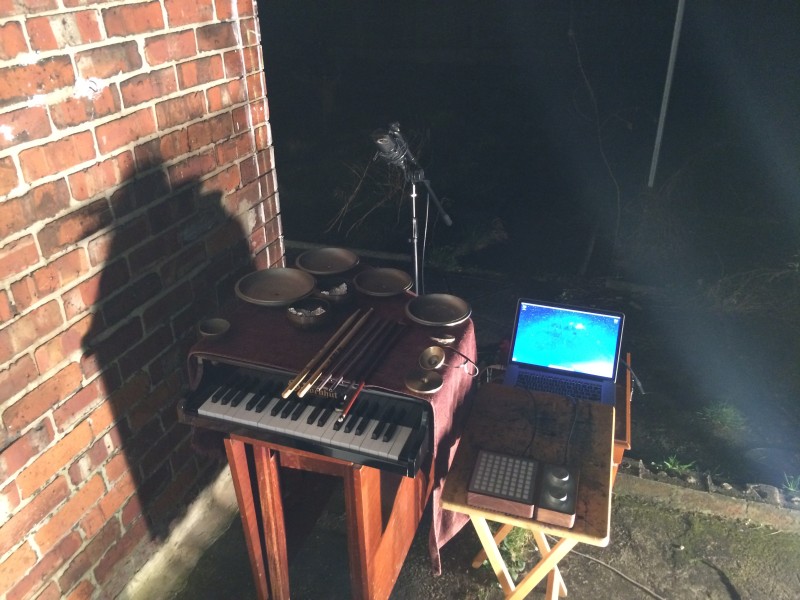
Everything. Everything at once. Once. (2c)
The visual look of these pieces is quite important, as the video IS the art object, not merely a documentation of it. Given my long-standing collaboration with Angela Guyton, she is responsible for all of the filming of these pieces. A new collaborator in this context is Linda Jankowska. During these performances Linda is operating the lighting, but she is also responsible for some of the framing, placement, and approach used in each video. Her lighting work in the videos is beautiful, particularly since she has such ‘performer’ sensitivity, she is able to follow my thinking while performing and complement the musical material visually. With Angie’s filming and Linda’s lighting I think the videos came out beautifully.
Everything. Everything at once. Once. (2d)
Here is the ‘score’ for version (2).
1 x Schoenhut 379B Toy Piano
1 x 6.5″ Cast iron pot lid
1 x 6.75″ Cast iron pot lid
1 x 7.5″ Cast iron pot lid
1 x 9″ Cast iron pot lid
2 x Singing bowls (with tin foil)
2 x Bell chimes
1 x Crotale
1 x Bell from bell tree
2 x Knitting needles
2 x Peter Erskine drum sticks
1 x Shortened Cello bow
1 x The Party Van 1.0beta
1 x monome 64
1 x monome arc2
1 x MacBook Pro
1 x MOTU Microbook II
1 x Mackie SRM350v2
strikethrough me & you – live
Some more me & you action, this time live. Oddly enough, even though we’ve been at this for a while, this was our first live performance. The set went really well, to a full house at The Noise Upstairs.
Still working on the mixes from the recording session at the end of last year and will release all the tracks for free once they are ready. For now here are a few of the performances from our first gig.
strikethrough me & you – in the studio
I’ve been working on a duet project (me & you) with Sam Andreae for well over a year now. We started shortly after he moved back to the UK after spending a couple of years in Scandinavia. It started off innocently enough, just as drum/sax free improv. That later blossomed into the idea for Battle Pieces. The idea is simple enough, a kind of challenge/battle/etude where we perform (often) against each other.
In content it is very similar to what I’ve been doing with other recent compositions (.com pieces, Everything., an amplifier) where I compose interaction, behavior, and relationships, instead of ‘content’. In the Battle Pieces the challenges are much more difficult and intense and have forced Sam and I to change/adapt/improve as improvisers drastically.
In December 2013 we decided we had enough of these pieces to go into the studio.
Before I run at the gob some more, here is Glitch Beat from the recording session:
We recorded 8 pieces total, with alternative takes being filmed by Angela Guyton on the second day in the studio.
I’ve become less interested in the idea of “releases” over the years, particularly since I hate getting CDs from people. I do like the art object of a release, which is why many of my releases over the years have been hand-made in one way or another, but even that idea has been waning. This has coincided with my increased video output, not so much as a kind of documentation, but as the thing itself. I do think that me & you is a live band, and we will play many gigs together, but as far as this recording goes, the current idea is to release each track individually, and for free. We’ve talked about eventually putting together a deck of cards with each piece written on each card, so at gigs we can pull out random cards and have our set determined that way, but we need to write many more pieces before we are at that point.

If the background looks familiar, it is because it is in the same studio where I recorded a follow up album with PA Tremblay in 2012. Due to PAs busy schedule, the recording is still in post, but it’s a doozy, and should hopefully be out in 2014.
My setup is equally stripped down, just being a 3-piece acoustic kit with 2 cymbals (1hat, 1ride), but after moving down to just a 2 piece setup, I’ve decided to add a single small (tiny) tom to complement the setup. I find that with me & you in particular, the alternate color of the tom works really well.
Here is one of our newer pieces, Flurries:
This piece is quite a departure for us in terms of sound world, but we’re both very happy with it. It was composed a couple of weeks before going into the studio, and the interactions were only finalized in the last rehearsal before the studio.
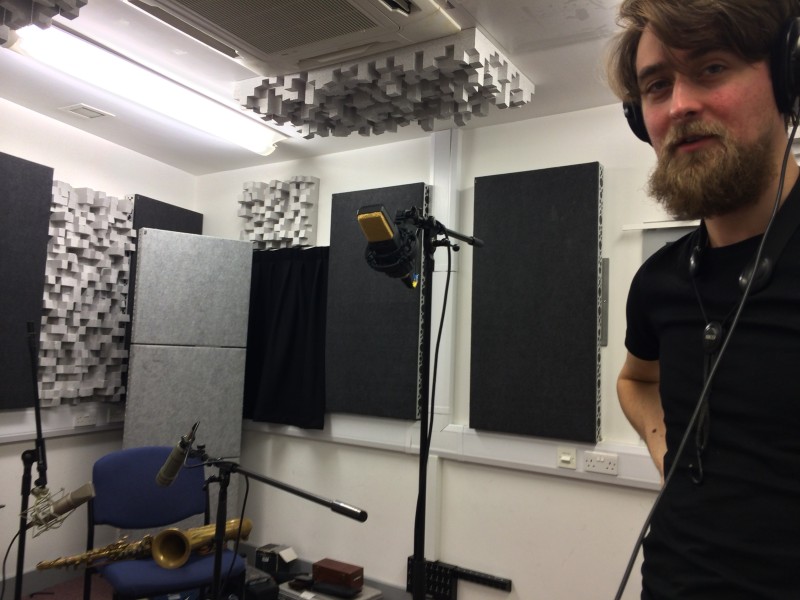
We have not finished ‘notating’ most of the pieces, which requires careful consideration of the wording, but here are 5 of the scores.
an amplifier, a mirror, an explosion, an intention
Early in 2013 a close friend of mine, Linda Jankowska, asked me to write her a violin piece. Despite her being an amazing and dedicated violinist, I told her no. I added “I don’t believe in violin”. I don’t think she had ever heard those words before….
Fast forward to now, the end of 2013. I still don’t believe in violin, but I wrote her a piece. The piece does not specify instrumentation. The instrumentation is simply “for Linda”.
Here enters : an amplifier, a mirror, an explosion, an intention
This piece is very different from the kinds of things I’ve been working on lately. One massive difference is that I’m not playing at all. The trajectory of my work, as of late, has been to compose/perform/improvise myself, or with very close collaborations in which I am also a performer.
The intellectual framework of the piece is also new. The .com pieces, Battle pieces, and Everything. Everything at once. Once., dealt with memory, challenge/etude, and instrumentation respectively. In ‘an amplifier’ I shift the focus from ‘composition’ to ‘improvisation’ in terms of where the brain juice is poured.
Here are the performance notes from the score:
Thinking about decisions in time
Decision making, in time, is separated into four streams. These all happen at once, with your active brain shifting between them. Throughout the piece you will be asked to privilege one kind of decision over the other.
There is an amount of overlap between these decision streams, which is intentional. The decision streams are not meant to be codified or exhaustive, but rather meant to draw emphasis to a certain area.
Material – Decisions dealing with manipulations of local material. This can come in the form of instrumental behaviours or general development, but is open to context and interpretation.
Formal – Decisions dealing with form and transitions.
Interface – Decisions dealing with instrument, ergonomics, technology, and performance modalities.
Interaction – Decisions dealing with how materials interact. This is primarily dealing with simultaneous materials (as opposed to Formal decisions), but is not exclusively so.
The idea for decision streams came after creating the Everything. Everything at once. Once. videos (filmed, as always, by Angela Guyton). I began analyzing my improvisations in those videos in terms of the actual (honest) decisions I make in time. This is central to what I actually do in a performance. Make decisions, in time. The categories came from analyzing the types of decisions I noticed myself making, and trying to make them general enough to apply to other performances.
This is the first piece in which I apply this idea.
Another new idea is that of time resonances. The term is borrowed from Terence McKenna, though I do not use it in the same way he does. For me it is also central to what I do as an improviser. Occasionally things happen in improvisation, things beyond myself, beyond my ability, and understanding. The things that can happen when you become an antenna. These cause a rift in the universe and create a drawing about the future/past…oh wait.. I digress.
I got the idea for time resonances from realizing that all the snare/feedback stuff (.com pieces) that I had been doing had been born in a 30second bit of improvisation from a tour I did a couple of summers ago. That idea resonated into each of the .com pieces, as a ‘harmonic’ of that idea ‘fundamental’.
All of that makes up the intellectual framework, but that is not the piece. The piece is for Linda.
Everything. Everything at once. Once.
Following on from the compositional ideas I had been developing in my .com pieces (form as content) and Battle pieces (challenge as content), I’m working on a new set of pieces where the choice of instruments is the composition.
Instrumentation as content.
This is how I approach most of my improv stuff, particularly coming from a multi-instrumentalist/DIY place. The choice of the instruments/devices is very much part of the creative process. I hadn’t formally considered this as part of my process before, but it was definitely there. It zooms out on the scope of my compositional thinking from being about interaction/form/memory to happening before any formal elements take place at all.
Before I say more, here is composition 1a from the series:
The seedling for this way of thinking was some recent collaborative experiments with honest and able violinist Linda Jankowska. She had me dust off my stringed-drum bits and was playing with that for a while. It got me thinking about how much an instrument/setup, particularly an esoteric one, lends itself to a certain kind of playing. What you do in context is, to an extent, articulating what you had in mind when you put those instruments together.
Shortly after Angela Guyton filmed her videos, I decided that I would make some videos of my own. I decided on the following setup:
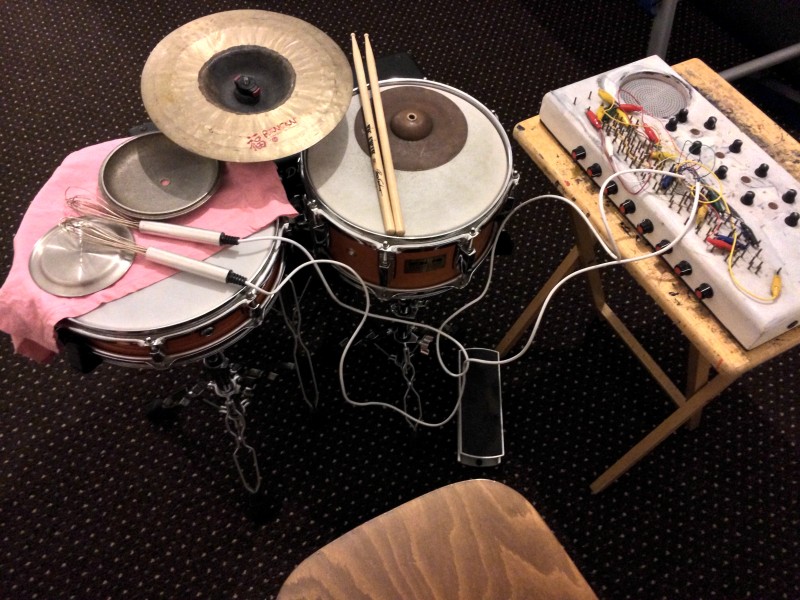
1 x 12″ Pork Pie snare drum
1 x 13″ Pearl snare drum
1 x 12″ Rancan chinese cymbal
1 x 6.5″ toy cymbal
1 x 6.5″ Cast iron pot lid
1 x 4″ Coin dish
1 x Beaker t-shirt
1 x ciat-lonbarde Fourses (Electric Whisks)
1 x Fender Deluxe amplifier
1 x Ernie Ball volume pedal
At this point I hadn’t yet decided on using this as a compositional approach. It was just part of my creative process.
The title of the series of pieces is “Everything. Everything at once. Once.”.
I think it really suits this way of thinking about composition. I don’t know where this compositional approach begins and my normal creative process ends, but I don’t think I will compose a gigantic amount of these pieces. For now, it is something I am exploring.



